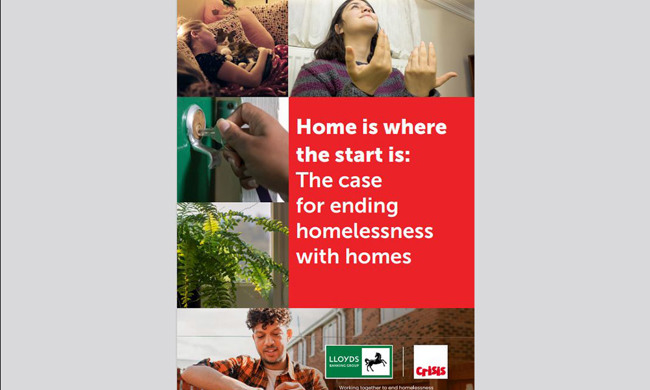Home is where the start is: The case for ending homelessness with homes
11.04.2023
This report, published in partnership with Lloyds Banking Group, draws on a range of evidence and data sources to present the case for placing provision of good quality, affordable, settled homes at the centre of solutions to homelessness.
A press release announcing the launch of a partnership between Lloyds and Crisis, and Crisis' plan to launch a not-for-profit lettings agency, can be found here.
Summary findings
A future where homelessness is ended – where experiences of homelessness that cannot be prevented are rare, brief, and non-recurring – is achievable in our lifetime. But it is impossible to end homelessness without homes.
A safe and settled home is the foundation on which people can build a decent life and meet their true potential. But we are increasingly seeing that people on lower incomes, including those in receipt of benefits, have fewer and fewer options because the homes that are available are either unaffordable, too difficult to access, or very poor quality:
- A survey carried out by Crisis with a nationally representative sample of low income households show that close to two million households (1.8 million) on low incomes are being forced to live in poor conditions – including living with damp, mould or in overcrowded accommodation – because their incomes are failing to keep up with rapidly rising rents and the increasing cost of living.
-
Analysis of ONS data shows that high rents coupled with rising living costs meant that, by the turn of 2023, the poorest 10 per cent of households were on average spending more than their income just on rent, energy and food.
-
There are almost 1.5 million households on social housing waiting lists across England, Scotland, and Wales, with the bulk of this number - 1.2 million - waiting for a home in England, although research has shown the true scale of need to be considerably higher.
-
At the same time, there are far too many homes sitting empty with no one benefiting from the stability they can provide. Empty homes represent wasted opportunities to provide decent, affordable housing to protect people from the misery of homelessness. In 2022 there were 321,832 ‘long term’ empty homes in Great Britain.
Solutions
There is an urgent need for more homes that provide security, decent living conditions and manageable rents - not having enough is driving levels of homelessness in the wrong direction. To achieve this, we need to see political action across the two following areas:
- A significant increase in new supply of social rented homes. It is not just about numbers - homes need to be the right types and in the places they are most needed.
- Unlocking access to more homes in the PRS by making sure housing benefit levels cover the true cost of rents in the cheapest 30 per cent of the market and supporting the sector to make better use of existing homes and unused commercial buildings to deliver new, innovative solutions.
But if we want to end homelessness, we can no longer stand by and wait for systemic solutions alone to adequately address the scale and nature of the challenge. This is why Crisis is taking direct action, to demonstrate first-hand what can be achieved when providing settled homes is recognised as the lynchpin to any plan to end homelessness for good.
The following principles will underpin our activity to increase the volume of homes available to help end homelessness:
- Quality - Homes will provide an environment where the people living there can make a home, feel safe, and where their dignity is protected. This includes providing adequate internal space, ensuring homes are resilient to climate change and taking steps to minimise negative environmental impact.
- Affordability - Rents will be affordable for the people living there, by making sure for example, that for people on lowest incomes, rent levels are set no higher than relevant housing benefit rates. Appropriate steps will be taken to minimise fuel poverty and the costs associated with moving into a new home.
- Accessibility - Mobility issues will be accounted for, and homes will be within a reasonable distance of important local amenities and public transport links. Homes will be allocated based on a person-centred approach - people will come first.
- Settled - People will know they can live in their home for as long as they need and want to, providing them with opportunities to establish a connection and contribute to their community. Tenants will also be able to access the support and information they need to leave homelessness behind for good

